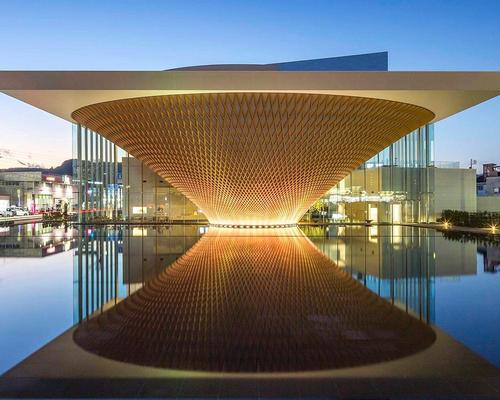08 Jan 2018
Shigeru Ban completes dramatic Mount Fuji World Heritage Center in shadow of famed volcano
BY Kim Megson

The Pritzker-winning architect Shigeru Ban has completed the dramatic Mount Fuji World Heritage Center in Japan’s Yamanashi prefecture, with a design that mimics the famous dormant volcano.
Located 20 miles southwest of the natural landmark, Ban’s 3,400sq m (36,500sq ft) facility is formed by an inverted latticed timber cone, that appears mountainous when seen in the large reflecting pool at the front of the complex.
Inside, exhibitions tell the story of the 3,776m (12,389ft) World Heritage site, the history of the Fuji-ko religion it inspired, and its role in popular culture.
Videos and audio recordings feature, as do artworks and a 15m-wide (49ft) recreation of Mount Fuji made from Japanese paper.
Other facilities include a 4K theatre, a library, an event space, a restaurant and a shop.
Visitors can ascend the building via a 193m (633ft) spiral slope that simulates a climb up the volcano – Japan’s highest peak. A viewing tower in the cone with full-height glazing frames the real thing in the distance.
Mount Fuji was recognised as a UNESCO World Heritage Site in 2013 and a competition was held shortly afterwards to choose a design for the Fuji World Heritage Center. The winning submission was selected ahead of over 230 rival proposals.
Ban’s best-known cultural buildings include The Centre Pompidou-Metz museum in France, the Aspen Art Museum in the US and his recently-opened ‘music city’ on Paris’s Île Seguin island.
In 2014, when he won architecture’s top prize, the Pritzker Jury cited Ban for his innovative use of simple materials, such as timber, paper and cardboard, and his dedication to humanitarian efforts, calling him "a committed teacher” and an “inspiration".
In a 2016 interview, Ban told CLADglobal: “Whatever the project, it's important to respect the characteristics, trademark or tradition of the place. I don’t strive to create beautiful and aesthetic architecture, but these characteristics appear naturally from a design. It's something an architect senses.”
Close Window